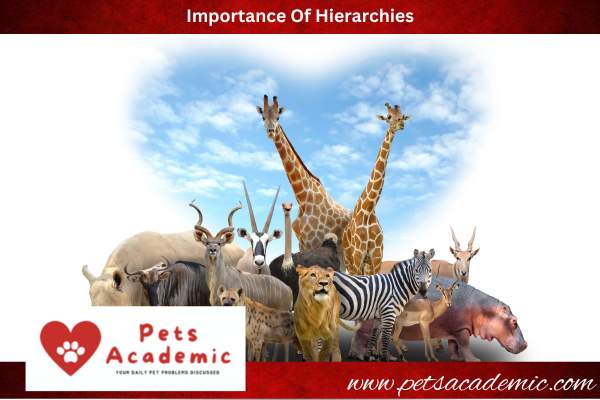Animal hierarchies have always been a fascinating topic for researchers around the world.
Observing how different species interact with each other, and how they establish dominance and structure within their social groups has shed light on the complex behaviors of animals.
In simple terms, hierarchy refers to the structured ranking of individuals within a group, based on dominant behavior, age or sex.
While hierarchy among animals may seem brutal to human observers, it is an important survival tool for many species.
What Are Animal Hierarchies And Why Are They Important?

Animal hierarchies play a crucial role in maintaining order and stability within social groups.
The core reason for the establishment of such structures is to avoid conflicts and maintain cohesion in the group.
Dominance behavior, or the display of dominant postures and aggression, determines the hierarchy in most species.
Animals that display such behavior are usually higher in the hierarchy, while those that are submissive hold a lower rank.
Hierarchies are also important in ensuring that resources such as food, water and shelter are distributed fairly among group members.
Dominant animals get first access to these resources, while the submissive ones wait their turn.
This prevents competition within the group and ensures that all members get a fair share of resources.
The Role Of Hierarchies In Animal Societies

In many animal species, such as primates, elephants, and lions, the hierarchy determines access to mating partners.
Dominant males have the highest number of mating opportunities, but they also have to fight challengers from other males who wish to take over their position.
This creates a constantly evolving hierarchy, with dominance changing hands frequently.
Hierarchies also play a vital role in the upbringing of offspring.
In many species, dominant females will often take care of and protect the young of the group.
This ensures the survival of the species and, since the young are related to the dominant female, it ensures that her genes get passed down to the next generation.
Dominance Hierarchies

Animal hierarchies refer to the social structures established within a group that dictate how individuals interact with each other.
Dominance hierarchies, in particular, refer to the ranking of individuals based on their display of dominant behavior, which includes aggression and posturing.
Dominant individuals hold a higher rank, while submissive ones hold a lower rank.
The establishment of dominance hierarchies plays a crucial role in resource distribution, maintaining order, and minimizing conflicts within the group.
Dominant animals get priority access to resources such as food, water, and shelter, ensuring that all members get a fair share of resources.
Furthermore, in many animal species such as primates, elephants, and lions, the hierarchy determines access to mating partners.
Dominant males have more mating opportunities, but they have to fight challengers from other males who wish to take over their position.
This creates a constantly evolving hierarchy, with dominance changing hands frequently.
In addition to resource distribution and mating access, dominance hierarchies also play a vital role in the upbringing and protection of offspring.
Dominant females often take care of and protect the young of the group, ensuring the survival of the species.
Alpha Animals
Dominance hierarchies are prevalent in many animal species, and the highest-ranked individual is often referred to as the alpha animal.
In some species, the alpha animal is the strongest or biggest member of the group, while in other species, it’s the most dominant or aggressive.
In some animal groups, such as wolves, the alpha status is determined through physical competition.
The wolf who wins fights or asserts dominance over other wolves becomes the alpha.
However, in other species like primates, the alpha status is not solely decided based on physical strength.
Intelligence, social skills, and strategic thinking often play a crucial role in determining the alpha.
The alpha animal has access to the best resources and mates and is also responsible for maintaining social order within the group.
They are often responsible for protecting other group members, making important decisions, and distributing resources such as food and water.
In some animal species, the alpha animal may change frequently due to challenges from other group members or because of natural changes such as aging.
The loss of an alpha may lead to conflict within the group until a new alpha is established.
Social Hierarchies

Social hierarchies exist in many animal species and are similar to dominance hierarchies in some ways, but there are some key differences.
While a dominance hierarchy is based on physical competition and the highest-ranked individual is often referred to as the alpha animal, a social hierarchy puts more emphasis on social skills, communication, and cooperation.
In a social hierarchy, individuals may not necessarily be ranked according to physical strength or aggression.
Instead, those with better social skills and the ability to communicate effectively may be higher up in the hierarchy.
For example, in some primate societies, an individual with strong social connections and alliances may be more influential than a physically dominant male.
Like dominance hierarchies, social hierarchies can have a significant impact on the social structures and behavior of animal groups.
Individuals who are higher up in the hierarchy often have access to better resources and mates, and they may also play a larger role in maintaining social order and resolving conflicts within the group.
Understanding social hierarchies can provide valuable insights into the behavior and social structures of various animal species.
By studying how animals navigate social hierarchies, researchers can gain a better understanding of how different factors such as communication, cooperation, and social connections influence an individual’s rank within their social group.
Matrilineal Societies
Matrilineal societies are social systems in which descent and inheritance are traced through the mother’s side of the family.
This is in contrast to patrilineal societies, where descent is traced through the father’s side of the family.
In matrilineal societies, women often hold more power and have a central role in the family and community.
In these societies, women are often responsible for the transmission of cultural values and knowledge, as well as the distribution of resources within the family.
This can include the allocation of land, animals, and other important resources.
Women may also play important leadership roles within the community, such as serving as religious or political leaders.
One example of a matrilineal society is the Minangkabau people of Indonesia.
In this society, land and property are inherited through the female line, and women are often the primary decision-makers in both the family and community.
Another example is the Mosuo people of China, where households are typically headed by women and men have more fluid roles in the family.
While matrilineal societies may seem like a reversal of traditional gender roles, it is important to note that they function differently than matriarchal societies.
In matriarchal societies, women hold absolute power and dominate over men, while in matrilineal societies, men and women still have their own roles and responsibilities within the family and community.
Patriarchal Societies
Patriarchal societies are social systems in which descent and inheritance are traced through the father’s side of the family.
This is in contrast to matrilineal societies, where descent is traced through the mother’s side of the family.
In patriarchal societies, men often hold more power and have a central role in the family and community.
In these societies, men are often responsible for the transmission of cultural values and knowledge, as well as the distribution of resources within the family.
This can include the allocation of land, animals, and other important resources.
Men may also play important leadership roles within the community, such as serving as religious or political leaders.
One example of a patriarchal society is the Masai people of Kenya and Tanzania.
In this society, men hold all political power and make important decisions for the community.
Women’s roles are often limited to domestic tasks and childbearing.
Another example is Saudi Arabia, where women are legally required to have a male guardian and have limited rights in areas such as education, employment, and politics.
While patriarchal societies may seem like a reinforcement of traditional gender roles, it is important to note that they function differently than a patriarchy as a political system.
In the latter, men hold the majority of power in government and institutions.
Patriarchy as a social system can manifest differently across cultures and communities.
Communication In Hierarchies
The animal kingdom is full of social structures and hierarchies, with many species relying on communication to maintain order.
One way this is done is through the use of vocalizations and body language to communicate rank and status within a group.
For example, in many primate societies, such as chimpanzees and baboons, dominant individuals will often make loud vocalizations and display confident body language to assert their status.
This can involve puffing up the chest, standing upright, and making eye contact with others in the group.
In contrast, subordinates may exhibit submissive behaviors, such as avoiding eye contact or making themselves appear smaller by hunching over.
Other animals rely on scent marking or physical displays to communicate their rank.
For example, male elk will often rub against trees or vegetation to leave behind their scent, which other males can then detect to determine their strength and dominance.
Similarly, male peacocks use their brightly colored feathers and elaborate displays to attract mates and demonstrate their fitness.
Interestingly, communication within animal hierarchies is not always straightforward.
Some animals may engage in deception or subterfuge to gain an advantage over others, such as faking aggression to scare off potential challengers.
In addition, rank and social status can be fluid, with individuals constantly jostling for position within the group.
Understanding how animals communicate within hierarchies can provide important insights into human behavior and societal structures.
By studying these systems, researchers can develop a better understanding of how power dynamics work and the ways in which communication can be used to assert dominance or challenge authority.
Importance Of Hierarchies

In the animal kingdom, hierarchies play a crucial role in maintaining social order and ensuring the survival of the group.
By establishing clear rankings, animals can avoid conflicts and conserve energy, while also maximizing their chances of accessing resources such as food and mates.
Hierarchies are particularly important for animals that live in groups or herds, such as primates, elephants, and wolves.
In these species, dominant individuals play a key role in leading the group, defending against predators, and guiding the movements of the herd or pack.
By asserting their dominance, these individuals also gain priority access to resources such as food and prime mating opportunities, which can further boost their chances of survival and reproduction.
One reason why hierarchies are so effective in promoting social cohesion is that they rely on clear signals of status and rank.
As discussed earlier, animals use a variety of communication methods to signal their position in the group, including vocalizations, displays, and scent marking.
By quickly detecting these signals, other individuals can avoid challenges or conflicts with higher-ranked members, which can ultimately benefit the group as a whole.
Of course, hierarchies are not without their downsides.
Lower-ranked animals may experience stress and reduced access to resources, which can harm their physical and mental wellbeing.
In addition, rigid hierarchies can limit innovation and experimentation, as subordinates may be reluctant to challenge the status quo.
Nonetheless, in many cases, the benefits of a clear social structure outweigh the costs, helping promote the survival and success of the group as a whole.
Conclusion
In conclusion, understanding hierarchies in the animal kingdom can shed light on similar systems in human societies.
Researchers can gain insights into the social and psychological factors that shape human behavior by studying the ways in which animals communicate and establish dominance.
By developing strategies for promoting cooperation and wellbeing within our own communities, we can improve the overall success and survival of our society.
More Articles: The heartwarming stories of pets who found their way home.

